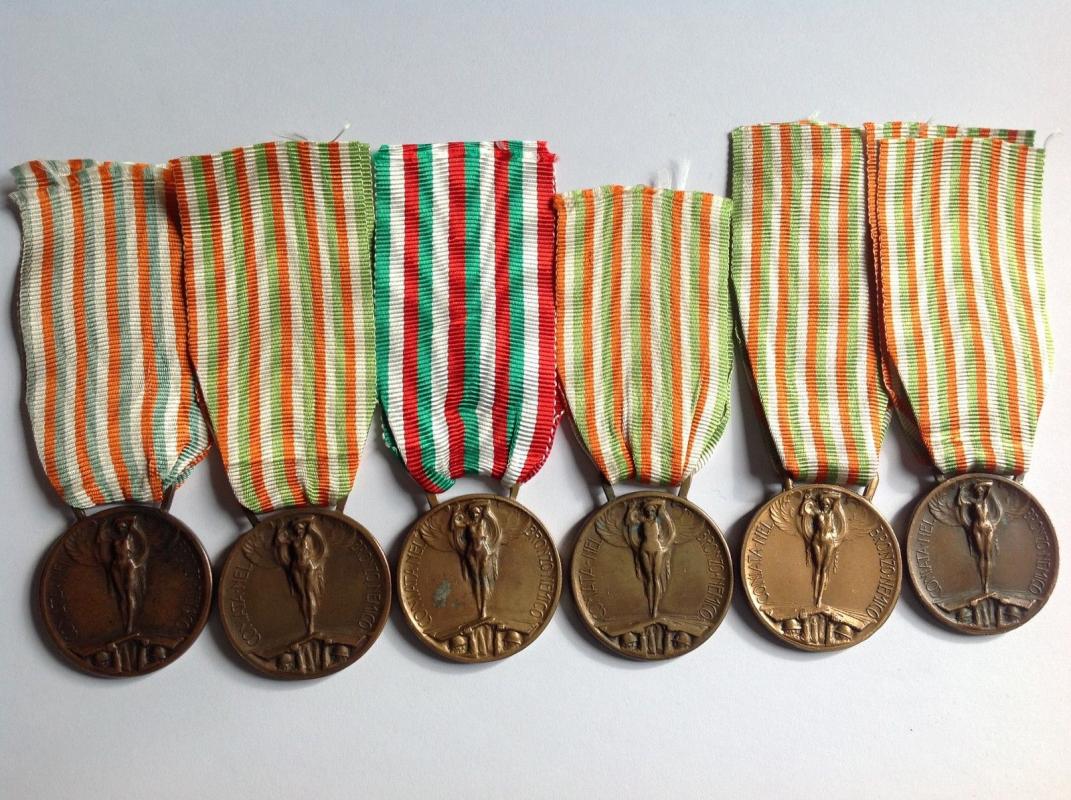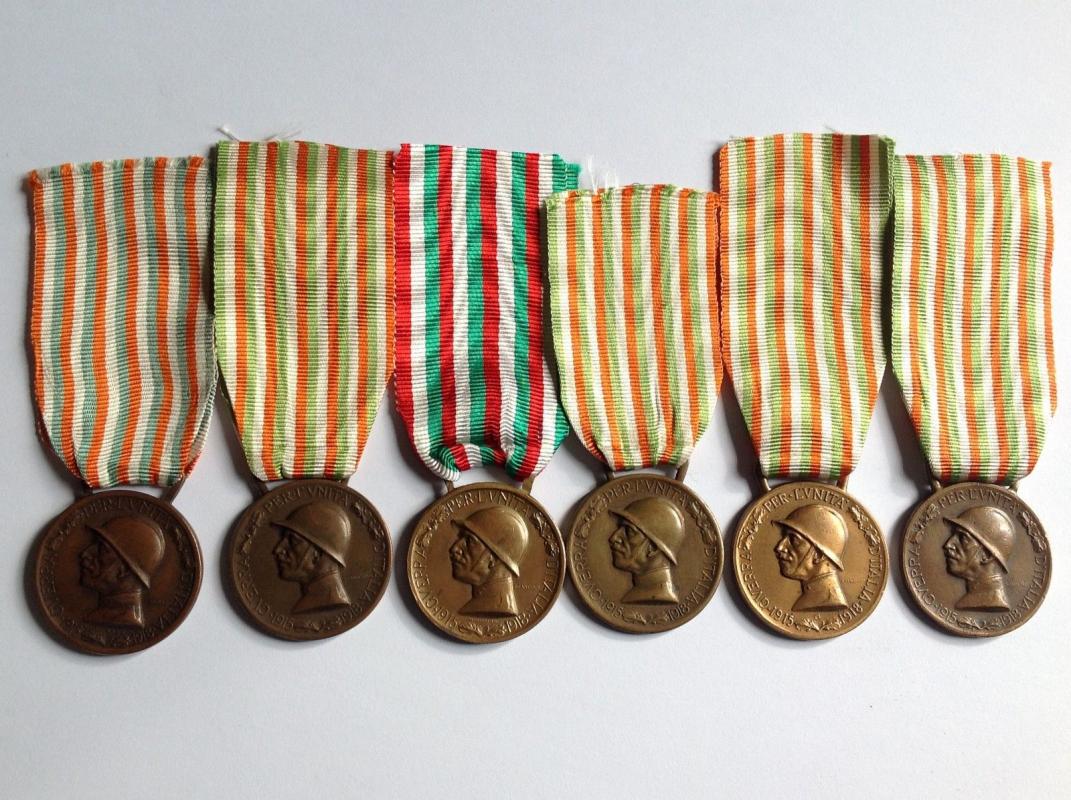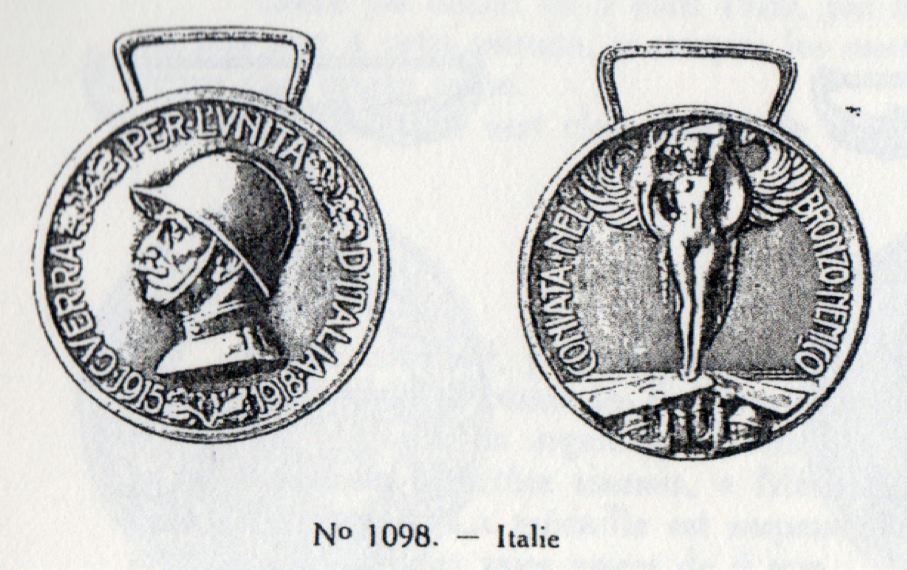-
Posts
1,155 -
Joined
-
Last visited
-
Days Won
1
Content Type
Profiles
Forums
Blogs
Gallery
Events
Store
Posts posted by RobW
-
-
To all,
Here are the reverses.
Regards,
Rob 0
0 -
To all,
Here are the obverses.
Regards,
Rob 0
0 -
To one and all,
There is, at the moment, a small collection of 6 different varieties of the Commemorative Medal on ebay italy.
The varieties are listed as:
- variante : S. Canevari / Mario Nelli
- variante : S. Canevari / Sacchini Milano
- variante : S. Canevari / C. M. [Lorioli-Castelli]
- variante : S. Canevari / S.J. (Johnson)
- variante : S. Canevari / S.I.M. Roma
- variante : S. Canevari
Noting that the auction is still in progress, and not being too presumptive I will post the pics for general information.
Regards,
Rob0 -
Hello Sergio,
Thank you for the clarification. If I understand correctly, the medal is an official issue of the first wave (let's say after WW1) while the ribbon comes from a medal produced the 1945-48.
Were these ribbons available to those veterans willing to replace the original one after 25 years of wearing?

What needs to be taken into account is that Czechoslovak Legion members sewed their medals directly to the tunic, or attached them to boule suspenders, and there are numerous pictures available to show this. No doubt over the passage of time some of these ribbons would have become worn and would have needed to be replaced.
There are numerous pics on this thread that showed the thicker weave and unblended type of ribbon common to Czechoslovak vics that was used in the first period (1920-1945). After 1945 and the Karnet & Kysely produced models appeared the newer blend or weave of ribbon is seen on those medals. Following the communist takeover in February 1948 the Karnet & Kysely firm was nationalised, so remaining records from that firm are not available.
While you can never be 100% sure I would suggest that if a particular veteran wanted to replace their medal ribbon they would source whatever stocks were available locally, either from manufacturers or tailors. If the Karnet & Kysely produced ribbon was available it would have been an option.
Regards,
Rob0 -
Hello Lambert,
Hi Rob.
welcome back.
I know that Type 1 Unofficial probably made in France had a ball suspension, and much like drawing with official Medal ... ?
But this has a ring suspension.LambertMy absences this year will be frequent due to work commitments.
I agree that the unofficial type 1 was probably made in France. This particular variety also has a similar high quality which is at least suggestive that it was produced in France. Even compared to the unofficial type 1 there are many similarities between the two; despite some small variations on the reverse.
Regards,
Rob0 -
Hello Gunner 1,
davidck and Bilco: What makes the suspension different is that it in the Type I it was produced separately from the planchet and then soldered to the planchet; in the Type II the suspension is part of the planchet. There is no doubt in my mind that the VM in eBay item 191029335680 is a Type I as it has all the characteristics of a Type I and the recipients Medal Index Card indicates that the VM was issued to him on 3 November 1920 (the Type II VM was not approved or produced until January 1921). I was the winning bidder on that lot and expect to receive it in the mail in the next few days. Once it arrives I will post some scans of the medal and the suspension.
Has this item arrived yet??
Regards,
Rob0 -
Hello rocketscientist,
My Lorioli's version of the Commemorative Medal for the War of 1915-1918, with two campaign bars: 1917 and 1918. No idea whether the bars are original.
There are quite a few different variations of these date bars. Some have been posted on this thread already but other variations continue to appear in the market. Given the large number of manufacturers of the medal it stands to reason that there would be a similar number of bar manufacturers.
These bars were also produced, both officially and unofficially, for service in Albania. These are now becoming quite difficult to obtain.
Regards,
Rob0 -
Hello Oliver,
Hello gentlemen!
Oiginal or a copy?
Oliver
I would agree that this piece is an unofficial strike. It is very close to the design of the official production, with some minor reverse die variations and the lack of the 'Kristesko' mark. Some collectors have suggested that this piece was made in France due to the high level of detail and production values; but this has yet to be conclusively established.
Regards,
Rob0 -
Hello David,
I belive I have something a little unusual here. I got this on eBay, because I'd never seen a silvered French vic before. Realizing it may have been silvered much later, I figured it wasn't much of a risk for $25. This is the standard Morlon variety, and you can see the silvering has worn away in some places, revealing the bronze beneath. Has anyone else seen something like this or know why/when it may have been silvered?
I apologize for the picture quality...you may just have to take my word for it that it has a mainly silver coloration.I have seen silvered-bronze examples of the French vic before. As has been suggested elsewhere on this forum whether or not a medal was silvered, or even gilt finished may have defended on the funds of the person wanting to wear the medal. In addition there is also the French reissue type vic which has both a reddish-bronze finish as well as a shiny-gilt finish.
Regards,
Rob0 -
Hello David,
Any comments on this example? It looks consistent with the genuine copies to me, but I figured I'd ask the experts.
As Dave posted at #39 of this thread this particular strike has been previously identified as a reproduction. While the exact manufacturer has not yet been established there are a number of die differences which should aid the vic collector in not being duped into thinking this is an official strike.
Regards,
Rob0 -
Hello Sergio,
Hello,
Yes it is a good example, Type 2 official, the ribbon is modern replacement.Lambert
I would clarify the comments from Lambert. The ribbon attached to your Czechoslovak vic is not necessarily a 'modern replacement'. It was produced at the same time as the Reissue type 1 and Reissue type 2 by the firm of Karnet & Kysely. This occurred between 1945-1948 so it is both correct to type and period and it is not uncommon to see the official Czechoslovak vics on this type of ribbon.
Great! Thank you.
Pity for the ribbon, unfortunately most of my Interallied Medals have new ribbons...
If you can find it I would attempt to replace any modern era nylon ribbon with correct to era french ribbon as that was also consistently used with vics from a number of countries and would be more correct...
Regards,
Rob0 -
Sergio,
As far as I have been able to identify the french medal manufacturers also produced the ribbons for the medals. I would suggest that maybe it is a french produced ribbon but don't have any further information than that. French ribbon that I have seen has different hues and colours than the original ribbons.
My example did not have any ribbon attached to it.
Regards,
Rob0 -
Hello Sergio,
Happy to help where I can.
Regards,
Rob0 -
And here is the scan of the accompanying description, from page 97.
Regards,
Rob 0
0 -
Sergio,
Here is a scan of the illustration from the 1934 Delande catalogue; page 95.
Regards,
Rob 0
0 -
Here is the picture of my french produced example.
Regards,
Rob 0
0 -
Hello Sergio,
The medal that you have described, and posted pictures of, is not a fake but a french reproduction contemporary to the period. It was produced in the early 1930's timeframe by the french medal production house of M.Delande in Paris. They were a well known french medal manufacturer who were a prolific producer of medals from not just France but a wide variety of european countries. During the same timeframe they produced medals and decorations from countries that were involved in the Great War of 1914-1918. These decorations and medals were illustrated in a fantastic 1934 catalogue produced by the Delande firm showing all the varieties.
It was commonplace for there to be die differences in these french made reproductions compared to the originals. The details that you showed in your pictures are consistent with a Delande manufactured piece and the file marks on the rim are also common in these pieces.
I will post a picture of my Delande manufactured reproduction, which was obtained during the final close-down sale of stock from that manufacturer, and you will see the details are the same. I will also post the illustration and entry from the 1934 Delande catalogue for your reference.
All in all you have a nice 1930's french produced reproduction of a nicely designed italian war commemorative medal.
Regards,
Rob0 -
Hello IrishGunner,
My medal above came with a mini...about 12mm diameter; ribbon is 35mm long (doubled).
And this little "wire" loop in the ribbon colors; it is about 18mm long and 2-3mm wide.
Also have a similar "wire" loop in the colors of the Commemorative Medal of the War 1914-1918.
The 'wire loop' is a designed for fitting on the lapel of a jacket. It is a commonly seen accoutrement especially with french and belgian items.
Regards,
Rob0 -
To one and all,
Here is another example of a French War Commemorative medal.
In this case it appears that the medal was struck without makers marks on the reverse. The BR mark and cornucopia of the Paris mint are actually stamped into the reverse planchet instead of being part of the design as usually seen. It seems odd that the BR mark and cornucopia are stamped into the planchet.
Has any other French collector seen such a variety?
Regards,
Rob 0
0 -
Hello David,
Thanks GM1, we're on vacation in Austria right now, but I'll post a picture of the reverse after we get home on Sunday.
On a separate note, I went into a military antiques store in Vienna and was very lucky in that I found the Lejsek and Riemer versions. I mentioned in another thread that I had been looking for those rather obsessively, so I was pleasantly surprised to find them in Austria, of all places. Anyone have an opinion as to why two hard-to-find Czech-made Belgian medals would be in Vienna? They had some other fairly common vics (Italian, French, Japanese, and British), but I was surprised to find these in particular.
Lejsek:
Riemer:A nice pair of a Leisek and a Riemer produced Belgian model vic. Of note is the Leisek is the unofficial type 1a variety with the 'LA' mark only on the reverse.
The unofficial type 1 Leisek variety is a bit more difficult to obtain and it has the 'LA' mark on both the obverse and reverse.
Once you get started down this road there just seems to be so many varieties to collect.
Regards,
Rob0 -
Hello David,
New acquisition: Greek official
While you have indeed picked up a nice Greek official vic it does appear to be missing the top part of the decorative suspension. The top half of this suspender is illustrated, in close-up pics, in posts #48 and #49 of this thread. It looks like yours has been replaced with a simple brass ring.
Regards,
Rob0 -
Hello David,
Got this at an antique fair in Belgrade--the Serbian commemorative medal. I pretty much limit my collecting to the Victory medals (and I am very much a beginner at that), but I figure I might as well get the equivalents from countries that didn't issue an official Vic, when the opportunity presents itself.
A nice example. It is a medal that appears frequently in French groups due to service in the Salonika theatre of war.
There is a specific thread on the different varieties of the Serbian commemorative medal for the Great War on another section of GMIC.
It is located at: http://gmic.co.uk/index.php/topic/23820-serbia-different-types-of-commemorative-wwi/
This thread also has some different award documents as well.
Regards,
Rob0 -
Hello David,
Here's my Cuban, which I understand to be an official version. I managed to get it relatively cheap, because it's somewhat beat up and is missing the suspension. Does anyone have a recommendation for how to attach a new suspension, for when I'm getting ready to have it mounted?
As Bill has alluded to; in order to repair this piece you would have to either denude another medal of a ball suspender or have one fashioned by a jeweler. An experienced jeweler should be able to solder such a sourced replacement onto the planchet. Either way it is not going to be an easy task.
I would keep the piece as a placeholder and wait until you are in a position to obtain another piece complete with ball suspender and suspension ring.
Regards,
Rob0 -
Hello David,
More confusion caused by the fact that my edition of Laslo's book is the 1st edition--I was unaware until I started posting here that there was an "unofficial" Japanese version. I had been assuming that this was the official version, but I'm hoping someone can confirm that for me.
Apologies for the sudden flurry of posts in 6 different threads, but as I'm a beginner, I find the knowledge on this forum to be valuable and hope to make more informed decisions in the future. Thanks.Yes; you have an official version. It has the barrel suspender and correct unblended ribbon.
I have posted some comparison pics of the official version next to the French made reproduction (which has a ball suspender) at #3 and #4 of this thread. They will clearly show the differences.
Regards,
Rob0




Italy - Commemorative Medal for the War of 1915-1918
in Southern European & Balkan States
Posted
Hello Sergio,
You will notice on the most recent posts of the 6 varieties that there are a number of different shades of the ribbon. This is a good example of the ribbon varieties as well.
I hope that this helps you in the identification of not only the medal varieties but also the ribbon varieties as well.
Regards,
Rob